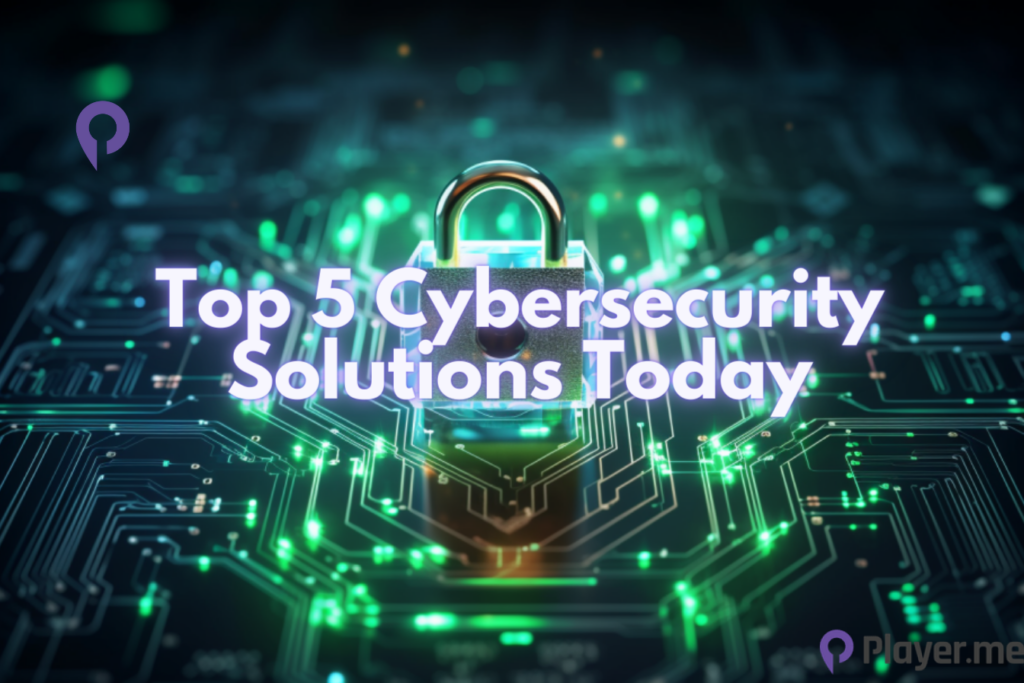With the threat of cyber intrusion ever-present in today’s digital landscape, safeguarding sensitive information and protecting networks have become paramount. As such, cybersecurity solutions have become highly crucial in preventing unauthorised access, data breaches, and other malicious activities. This article presents the top 5 cybersecurity solutions, highlighting their key features and benefits.
Also read: What Is the Internet of Things?
Next-Generation Firewalls (NGFWs)

Next-Gen firewalls are network security devices that optimise regular firewalls beyond their normal capacity. Although traditional firewalls are useful monitoring agents for outgoing and ingoing network traffic, they aren’t robust enough to protect against ever-evolving cyber threats.
Unlike traditional firewalls, NGFWs see past network layers into app protocols. This lets businesses enforce policies based on specific apps and control risks better. NGFWs also spot threats in real time. They monitor traffic for known threats and odd patterns. By blocking harmful activity as it happens, NGFWs lower the risk of hacks.
Also, NGFWs have constantly updated security databases to help digital infrastructure keep ahead of the curve. NGFWs get updated threat intel and integrate new intelligence to spot new threats.
As more businesses move away from the office to remote work in the aftermath of the global pandemic, NGFWs enable secure remote work by providing VPN access for employees to tap resources safely.
In addition, NGFWs integrate seamlessly with other security tools for centralised management and faster incident response. By using NGFWs, businesses benefit from better visibility, advanced threat spotting/blocking, improved app control and simplified security oversight.
Endpoint Protection Platforms (EPPs)
EPPs are essential in keeping devices safe in today’s digital world. With increasingly more endpoints like laptops, desktops and mobile devices targeted by cyber threats, EPPs provide complete protection. These cybersecurity solutions are cloud-based, using cloud services to carry out remote mediation and advanced monitoring.
EPPs combine antivirus, anti-malware and advanced threat detection to identify and stop harmful activities in real time. They also offer multi-layer security, ensuring endpoints are shielded from malware, ransomware and phishing attacks. EPPs often include extras like data encryption, device control and web filtering, boosting endpoint security further.
Security Information and Event Management (SIEM)

Strengthening threat monitoring and incident response is crucial these days for organisations. In light of this, centralised threat management solutions like Security Information and Event Management (SIEM) systems have become important with many security events and potential threats.
SIEM platforms collect data from different sources like firewalls, IDS, and endpoints. This real-time threat data gathering enables organisations to monitor threats better and provide actionable insights to quickly detect and respond to incidents long before they can disrupt business operations.
SIEM platforms also help organisations comply with regulations by generating comprehensive audit logs and security reports. With SIEM, organisations can improve visibility into threats, strengthen incident response, and maintain a robust security posture against evolving cyber threats.
Identity and Access Management (IAM)
IAM frameworks allow IT managers to control the extent of user access to various sensitive digital infrastructures within the organisation. Examples of Identity and Access Management solutions include two-factor authentication (2FA), multi-factor authentication (MFA), single sign-on systems, and privileged access management.
These cybersecurity solutions enable IT managers to securely store profile and identity data for all employees within the organisation and manage role-based data access to ensure that the most sensitive data remains accessible to only authorised personnel. IAM is one of the most popular cybersecurity solutions for businesses today, as it is highly scalable and can be deployed by organisations of all sizes.
Data Loss Prevention (DLP)

Protecting sensitive data from unauthorised disclosure or leakage is a top priority for organisations today. With Data Loss Prevention (DLP) solutions, organisations can identify, monitor, and protect sensitive data throughout its lifecycle. DLP services offer a comprehensive approach to preventing data breaches and ensuring data security and employ technologies and policies to affect content analysis, encryption, and data classification to prevent data loss incidents caused by internal or external threats.
DLP solutions enforce data usage policies, monitor data transfers, and provide real-time alerts when potential data breaches are detected. By implementing DLP, organisations can mitigate the risk of data breaches, maintain compliance with regulations, and protect their valuable and confidential information.
Conclusion
In the face of growing cyber threats, organisations need robust cybersecurity solutions to safeguard their digital assets and maintain customer trust. Cyber threats aren’t static. Instead, they constantly evolve. As such, organisations must deploy cybersecurity solutions that align with the best industry practices.
By implementing the most up-to-date solutions and not waiting till the threats surface before enabling the fixes, organisations can enhance their security posture and protect their critical data and systems from ever-evolving threats.
Frequently Asked Questions
How Do Cyber Security Solutions Address Compliance Requirements?
Many of the solutions are designed to assist organisations in meeting compliance requirements. They also provide features such as logging, reporting and access controls, which help organisations demonstrate compliance with industry-specific regulations, e.g. PCI DSS, HIPAA or GDPR.
How Can Organisations Determine the Right Combination of Cybersecurity Solutions for Their Needs?
Organisations should evaluate what’s most needed, assess risks and spending limits, and then consult cyber experts or consultants to find solutions suiting their needs and purposes.
Can Cyber Security Solutions Be Integrated into Existing IT Infrastructure?
Yes, various solutions are designed to integrate with existing IT infrastructure. NGFWs, EPPs, SIEM systems, IAM solutions, and DLP platforms can be deployed and integrated with various network architectures and security frameworks, providing seamless protection without disrupting operations.





